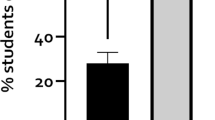Abstract
With rapid advances in the biosciences, bioethics has become an important, if not vital part of a comprehensive bioscience education. Students who successfully complete a course in bioethics will be better equipped for writing manuscripts for publication, preparing research proposals for funding bodies and completing applications for research ethics committees. Given the importance of both grant writing and successful publication in a bioscience career, bioscience students who do not receive training in bioethics will be disadvantaged. Graduates who move into careers other than research, such as science policy, administration or education, will also benefit from the inclusion of bioethics in their bioscience education because they will need to consider the ethical issues that arise in the context of policy, public relations and public health. Given the importance of including bioethics in a bioscience education, this paper presents the findings of an empirical study that was designed to evaluate the different ways to design and deliver a bioethics module for bioscience students. The study considers the aims and objectives; the teaching, learning and assessment strategies and the content of a ‘bioethics for bioscience’ module. At a more fundamental level, the study explores why bioethics should be taught, at what level bioethics should be delivered, how much time should be committed to the teaching of bioethics and the core topics that should be included in a bioethics module.
Similar content being viewed by others
References
Aveyard, H., Edwards, S., & West, S. (2005). Core topics of health care ethics. the identification of core topics for interprofessional education. Journal of Interprofessional Care, 19(1), 63–69.
Biggs, J. (1999). What the student does: teaching for enhanced learning. Higher Education Research and Development, 18(1), 57–75.
Bryant, J., & Baggott la Velle, L. (2003). A bioethics course for biology and science education students. Journal of Biological Education., 37(2), 91–95.
Bryant, J. and Morgan, C. (2007). Attitudes to teaching ethics to bioscience students: an interview-based study comparing British and American University teachers. Bioscience Education Journal, 9.
Consensus Statement (1998). Teaching medical ethics and law within medical education: a model for the UK core curriculum. Journal of Medical Ethics., 24, 188–192.
Crosthwaite, J. (2001). Teaching ethics and technology – What is required? Science and Education. 10: 97–105.
Downie, J., & Clarkeburn, H. (2005). approaches to the teaching of bioethics and professional ethics in undergraduate courses. Bioscience Education., 5(2), 1–9.
Eriksson, S., Helgesson, G., & Hoglund, A. (2007). being, doing and knowing: developing ethical competence in health care. Journal of Academic Ethics., 5, 207–216.
Goldie, J. (2000). Review of ethics curricula in undergraduate medical education. Medical Education., 34, 108–119.
International Committee of Medical Journal Editors (ICMJE). (2010). Uniform requirements for manuscripts submitted to biomedical journals. (http://www.icmje.org/urm_full.pdf).
Loewy, E., & Loewy, R. (2001). Bioethics at the crossroads. Health Care Analysis., 9, 463–477.
Lysaght, T., Rosenberger, P., & Kerridge, I. (2006). Australian undergraduate biotechnology student attitudes towards the teaching of ethics. International Journal of Science Education., 28(10), 1225–1239.
Mepham, J. (2008). Bioethics: An introduction for the biosciences (Second ed., ). Oxford: Oxford University Press.
National Bioethics Advisory Commission (NBAC)(2001). Ethical and Policy Issues in International Research: Clinical Trials in Developing Countries.
Nuffield Council on Bioethics (NCB) (2002) The Ethics of Research Related to Healthcare in Developing Nations.
Parsons, S., Barker, P., & Armstrong, A. (2001). the teaching of health care ethics to students of nursing in the uk: a pilot study. Nursing Ethics., 8(1), 45–56.
Quality Assurance Agency for Higher Education (QAA)(2007). Benchmark Statements for biosciences.
Ramsden, P. (2003). Learning to teach in higher education. Oxon: RoutledgeFalmer.
Reiss, M. (1999). Teaching ethics in science. Studies in Science Education., 34, 115–140.
Willmott, C., Bond, A., Bryant, J., Maw, S., Sears, H. and Wilson, J. (2004). Teaching ethics to bioscience students – a survey of undergraduate provision. Bioscience Education Journal, 3.
Author information
Authors and Affiliations
Corresponding author
Rights and permissions
About this article
Cite this article
Ekberg, M.E. Exploring the Design, Delivery and Content of a ‘Bioethics for the Biosciences’ Module: An Empirical Study. J Acad Ethics 14, 103–114 (2016). https://doi.org/10.1007/s10805-015-9246-2
Published:
Issue Date:
DOI: https://doi.org/10.1007/s10805-015-9246-2




